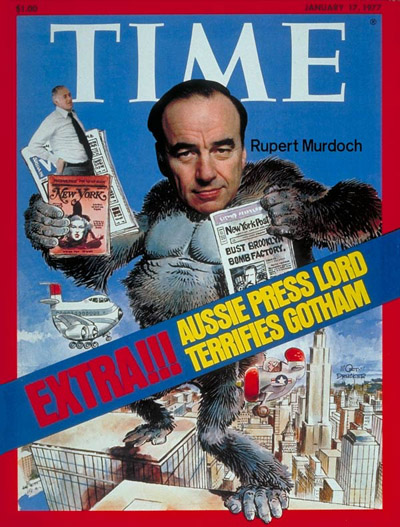
Media titan Rupert Murdoch is preparing to step down as CEO of 21st Century Fox and turn over the reins to his sons, according to reports on Thursday.
The move would continue a family legacy as media empire builders that reaches back to Murdoch’s father, Sir Keith Murdoch. A reporter for the Melbourne Age who made his name covering the Australian soldiers involved at Gallipoli during World War I, Keith Murdoch went on to thrive as a media executive. But he had little equity in the properties he ran–a lesson not lost on his ambitious son.
In a 1977 story, TIME explained how the gambling-loving Rupert Murdoch parlayed his father’s few remaining holdings into a global media behemoth:
Though Sir Keith had been chief executive of one of the nation’s largest newspaper chains, he held little stock, and death duties ate up most of that. The Murdoch family was left with a tired pair of newspapers in the southern Australian city of Adelaide and a radio station in remote Broken Hill. Says a friend: “That experience taught him the importance of 51% control.” Rupert set out to accomplish what his father had not. First he talked Sir Keith’s longtime friend, the capricious Lord Beaverbrook, into letting him apprentice as a $40-a-week subeditor on the London Daily Express. Then, at age 22, Murdoch went home to help run the Adelaide News and Sunday Mail.
He learned fast. When a rival daily quietly tried to buy the papers away from him, Murdoch front-paged the offer, accompanying it with an editorial thundering against the evils of press monopoly. When an aborigine was accused of murder on dubious evidence, Murdoch’s papers sprang to his defense; that unpopular act earned his small company a trial and subsequent acquittal on charges of seditious libel.
While building the family fortune, Murdoch loved to visit the radio station at Broken Hill, a mining city. There the prime diversion was Murdoch’s favorite pastime, gambling —specifically, the Australian national game of two-up, which is nothing more than flipping two coins at once (two heads you win; two tails you lose; one of each, toss again). As Murdoch is quoted by his biographer, onetime London Journalist Simon Regan: “I love to play it. You bet on a run. You go in with a couple of quid and two, four, eight, you double it all the time. If you’re betting on, say, heads, you can make hundreds if you get a run. Then it comes down tails and you’re all through. The real game is the gamble on exactly when to stop.”
Murdoch had never played two-up with a newspaper, and he was eager to try for a run. So in 1956 he bought a Sunday paper in Perth for $400,000, then four years later spent $4 million for the Sydney Daily Mirror, a racy tabloid weakened by incessant circulation wars. His Sydney invasion literally touched off new fighting. When Murdoch outbid a rival publisher for an Anglican Church printing plant, the rival tried to occupy the building. Murdoch allies rounded up a gang of hammer-wielding thugs and recaptured the plant after a bloody fight. At the same time, Murdoch turned the Mirror into a catalogue of crime and cheesecake, and it battled the rival Sun to a standstill.
In the late 1960s, Murdoch’s burgeoning empire expanded to include London papers and related ventures. His first experiment in the U.S. was a paper in San Antonio, and by 1976, he had the New York Post. By 1985 he’d bought half of 20th Century Fox, and he purchased the rest shortly after.
Read the full story, here in the TIME Vault: The Battle of New York
More Must-Reads from TIME
- Breaking Down the 2024 Election Calendar
- How Nayib Bukele’s ‘Iron Fist’ Has Transformed El Salvador
- What if Ultra-Processed Foods Aren’t as Bad as You Think?
- How Ukraine Beat Russia in the Battle of the Black Sea
- Long COVID Looks Different in Kids
- How Project 2025 Would Jeopardize Americans’ Health
- What a $129 Frying Pan Says About America’s Eating Habits
- The 32 Most Anticipated Books of Fall 2024
Write to Lily Rothman at lily.rothman@time.com